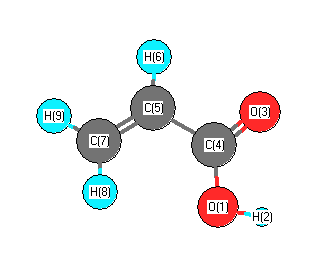Vibrational Frequencies calculated at BLYP/cc-pVDZ
| Mode Number |
Symmetry |
Frequency
(cm-1) |
Scaled Frequency
(cm-1) |
IR Intensities
(km mol-1) |
Raman Act
(Å4/u) |
Dep P |
Dep U |
|---|
| 1 |
A' |
3553 |
3559 |
44.45 |
|
|
|
| 2 |
A' |
3171 |
3176 |
5.18 |
|
|
|
| 3 |
A' |
3114 |
3119 |
2.96 |
|
|
|
| 4 |
A' |
3071 |
3076 |
5.05 |
|
|
|
| 5 |
A' |
1729 |
1731 |
243.19 |
|
|
|
| 6 |
A' |
1628 |
1630 |
13.33 |
|
|
|
| 7 |
A' |
1390 |
1392 |
22.42 |
|
|
|
| 8 |
A' |
1314 |
1316 |
29.19 |
|
|
|
| 9 |
A' |
1262 |
1264 |
1.82 |
|
|
|
| 10 |
A' |
1162 |
1164 |
153.42 |
|
|
|
| 11 |
A' |
991 |
993 |
86.50 |
|
|
|
| 12 |
A' |
802 |
803 |
4.72 |
|
|
|
| 13 |
A' |
561 |
562 |
37.22 |
|
|
|
| 14 |
A' |
512 |
513 |
6.70 |
|
|
|
| 15 |
A' |
273 |
273 |
0.57 |
|
|
|
| 16 |
A" |
1001 |
1002 |
14.63 |
|
|
|
| 17 |
A" |
953 |
955 |
20.14 |
|
|
|
| 18 |
A" |
803 |
804 |
27.29 |
|
|
|
| 19 |
A" |
595 |
596 |
77.04 |
|
|
|
| 20 |
A" |
467 |
468 |
9.03 |
|
|
|
| 21 |
A" |
114 |
114 |
0.06 |
|
|
|
Unscaled Zero Point Vibrational Energy (zpe) 14231.7 cm
-1
Scaled (by 1.0016) Zero Point Vibrational Energy (zpe) 14254.5 cm
-1
See section
III.C.1 List or set vibrational scaling factors
to change the scale factors used here.
See section
III.C.2
Calculate a vibrational scaling factor for a given set of molecules
to determine the least squares best scaling factor.
Charges, Dipole, Quadrupole and Polarizability
Charges from optimized geometry at BLYP/cc-pVDZ
Charges (e)
| Number |
Element |
Mulliken |
CHELPG |
AIM |
ESP |
| 1 |
O |
-0.148 |
|
|
|
| 2 |
H |
0.140 |
|
|
|
| 3 |
O |
-0.210 |
|
|
|
| 4 |
C |
0.120 |
|
|
|
| 5 |
C |
-0.026 |
|
|
|
| 6 |
H |
-0.016 |
|
|
|
| 7 |
C |
0.107 |
|
|
|
| 8 |
H |
0.018 |
|
|
|
| 9 |
H |
0.015 |
|
|
|
Electric dipole moments
Electric dipole components in Debye
(What's a Debye? See section
VII.A.3)
| |
x |
y |
z |
Total |
| |
0.818 |
-1.617 |
0.000 |
1.812 |
| CHELPG |
|
|
|
|
| AIM |
|
|
|
|
| ESP |
|
|
|
|
Electric Quadrupole moment
Quadrupole components in D Å
| Primitive |
|---|
| | x | y | z |
|---|
| x |
-26.113 |
4.697 |
0.000 |
| y |
4.697 |
-28.801 |
0.000 |
| z |
0.000 |
0.000 |
-29.609 |
|
| Traceless |
|---|
| | x | y | z |
|---|
| x |
3.092 |
4.697 |
0.000 |
| y |
4.697 |
-0.940 |
0.000 |
| z |
0.000 |
0.000 |
-2.152 |
|
| Polar |
|---|
| 3z2-r2 | -4.305 |
|---|
| x2-y2 | 2.688 |
|---|
| xy | 4.697 |
|---|
| xz | 0.000 |
|---|
| yz | 0.000 |
|---|
|
Polarizabilities
Components of the polarizability tensor.
Units are
Å
3 (Angstrom cubed)
Change units.
| |
x |
y |
z |
| x |
6.096 |
-0.005 |
0.000 |
| y |
-0.005 |
8.701 |
0.000 |
| z |
0.000 |
0.000 |
2.598 |
<r2> (average value of r
2) Å
2
| <r2> |
0.000 |
| (<r2>)1/2 |
0.000 |
